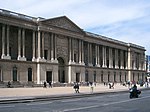Louvre Colonnade

The Louvre Colonnade is the easternmost façade of the Palais du Louvre in Paris. It has been celebrated as the foremost masterpiece of French Architectural Classicism since its construction, mostly between 1667 and 1674. The design, dominated by two loggias with trabeated colonnades of coupled giant columns, was created by a committee of three, the Petit Conseil, consisting of Louis Le Vau, Charles Le Brun, and Claude Perrault. Louis Le Vau's brother, François Le Vau also contributed. Cast in a restrained classicizing baroque manner, it interprets rules laid down by the ancient Roman architect Vitruvius, whose works Perrault translated into French (1673). Its flat-roofline design, previously associated with Italy and unprecedented in France, was immensely influential.
Excerpt from the Wikipedia article Louvre Colonnade (License: CC BY-SA 3.0, Authors, Images).Louvre Colonnade
Rue de l'Échelle, Paris 1st Arrondissement (Paris)
Geographical coordinates (GPS) Address Phone number Website Nearby Places Show on map
Geographical coordinates (GPS)
| Latitude | Longitude |
|---|---|
| N 48.860163888889 ° | E 2.3396416666667 ° |
Address
Palais du Louvre
Rue de l'Échelle
75001 Paris, 1st Arrondissement (Paris)
Ile-de-France, France
Open on Google Maps










